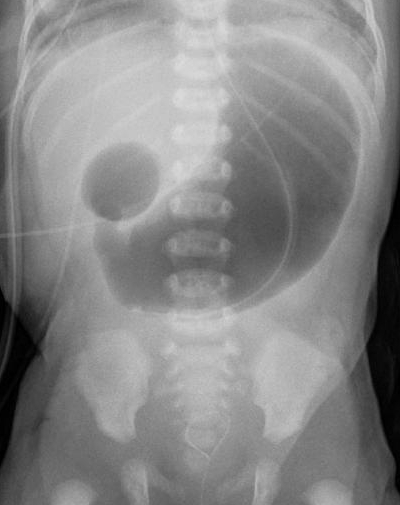Jejunal Atresia

Description
Jejunal atresia is the most common cause of bowel obstruction in the newborn. In this condition, because of agenesis of the mesentery, the distal small bowel comes straight off the caecum and twists around the marginal artery, suggesting a maypole, a Christmas tree, or an apple peel at operation. Obliteration of the superior mesenteric artery may underlie this malformation.
Clinical FeaturesMishalany and Najjar (1968) observed 3 affected out of 16 liveborn offspring of first-cousin parents; a fourth sib died at home with congenital high intestinal obstruction, bringing the number to 4 affected out of 18 offspring in this family (Farag et al., 1993). Blyth and Dickson (1969) reported 2 affected sibs in each of 2 families. Rickham and Karplus (1971) described 2 families with affected sibs.
Martin and Zerella (1976) proposed a classification of jejunal atresia into 5 types according to anatomic appearance: type I (mucosal web), type II (ends separated by a fibrous cord), type IIIa (ends separated by a V-shaped mesenteric defect), type IIIb ('apple peel' deformity, as discussed here), and type IV (multiple atresias). Type IIIb most commonly shows familial occurrence, although familial cases of types I, II, and IV have also been observed. See duodenal atresia (223400) and multiple intestinal atresia (243150).
Seashore et al. (1987) reported 3 cases, including 2 from the same sibship. They found reports of 57 cases in the English literature. Farag and Teebi (1989) described 2 Arab brothers with 'apple peel' jejunal atresia whose parents were consanguineous. Farag et al. (1993) reported 2 other affected sibs in the same family: later-born female and male infants.
Petrella et al. (1995) suggested that the apple peel syndrome may be a manifestation of cystic fibrosis (219700) in some instances. Roberts et al. (1998) studied the association between jejunoileal atresia and cystic fibrosis using population-based data from 1968 to 1995. Four of the 38 (11%) Caucasian jejunoileal atresia patients had cystic fibrosis. The observed-to-expected ratio is greater than 210 using a 1 in 2000 estimate for incidence, meaning that Caucasian infants with jejunoileal atresia have more than 210 time the risk for CF compared with Caucasian infants in the general population. This finding has important implications for prognostic and prenatal counseling.
Imaizumi et al. (1999) described apple-peel jejunal atresia in a Japanese girl who also showed an apparently balanced reciprocal translocation between chromosomes 2 and 3: t(2;3)(q31.3;p24.2)mat. The translocation breakpoints in the patient might be considered candidate regions for the gene mutant in apple-peel atresia. Alternatively, the association of the 2 abnormalities in the patient may have been coincidental since her phenotypically normal mother had the same chromosome translocation.